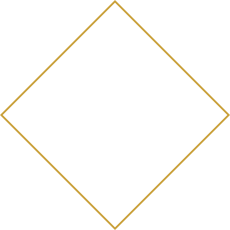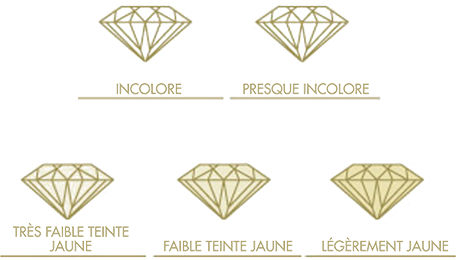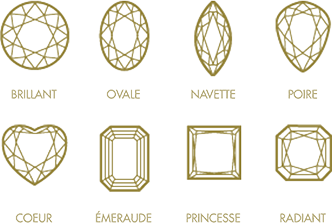Diamond

-The 1 C-
The quality and value of a diamond is determined by four criteria: carat, ie the weight of the diamond, color, distributing diamonds on a scale of whiter yellow-brown, purity, which raises the question of internal inclusions and surface imperfections stone, and size corresponding to the symmetry and proportion of the diamond, but also its shape cut: brilliant, pear, cushion, princess ... All these elements apply only to diamond, are called "4C" in reference to the English translation of these words: carat, color, clarity and cut. A certificate published by a gemological laboratory (GIA, HRD, LFG ...) will ensure the quality of the diamond. Nevertheless an expert eye can, especially if the diamond is not mounted, give an idea of its color and purity. Members of our team will be happy to look at your stone to give you a first opinion.-Carat-
The carat (abbreviated as "ct") of a diamond is its weight. Be aware that a program is 0.20 carat (one can speak of 20/100 or 20 points). The term "carat" originates from the fruit of the carob tree, the "carob". This fruit regular weight 0.2 grams was used as a unit of weight measurement in the gold trade. Diameter can give an idea of the carat weight of your stone, but nevertheless remain cautious: one stone "effect", ie cut with a large table and a shallow cylinder head, will give the illusion by its diameter of a stone to the large carats when the real weight might surprise you!-Color-
A color value scale growing of the letter D to the letter Z is used today by all gemological laboratories to classify diamonds more colorless tinted diamonds. each letter corresponds to a hue and color saturation as shown in the table below. Qualified diamond "fancy" are outside this scale: there are grouped diamonds with yellow or brown color is more intense than Z color diamonds, but all diamonds of one color other than yellow or yellow -Brown (pink, blue, green ...). Know that to "I-J" color of the diamond is a very commercial because the white stone "plays" white in daylight. The slight difference is seen in the diamond lamp and a discerning eye. These stones are quite pleasant if their size and brightness make them alive. In possession of a diamond with yellow highlights, a yellow gold mount mitigate these reflections. In contrast, a white gold setting or platinum will out the white brilliance of the stone. Of course, it is interesting to play with color contrasts.
-Purity-
In the same manner as the color scale is used to classify the purity of the stone taking into account the inclusions white or black colors present in the stone, but also its surface imperfections. An observation under 10x magnification allows to evaluate the inclusion type, color, size, number and position in the diamond. These elements are critical to the assessment of purity. A stone without any inclusions and free of defects on its surface is described as "pure" or "Flawless." It should however remember that the inclusions are not visible to the naked eye except diamonds "bitten" (Classified "I" for "Inclusions") whose gloss is impaired.10 times magnification

-Size-
The size of the diamond involves two aspects: On a certificate, the terms "poor", "fair", "good", "very good" or "excellent" refer to characteristics such as the proportions and symmetry of the diamond, his ability to take the light and refract , the thickness of girdle, but the polished diamond. In actual size "ideal" will come out a diamond to shine and the incomparable lights. In contrast, poor symmetry and proportion will be that the light will pass through the diamond without be reflected in the facets, causing dark areas. Moreover, Diamond Cutting also match its shape after the lapidary have earned. The most popular size is the so-called "brilliant cut" that is to say a round shape having 57 facets. Among the most classic sizes, we also find: size "emerald" which features a rectangular shape with cut sides, size "cushion", square shape with rounded corners, size "Princess", also square in shape but with sharp angles, size "pear", which has a wide base and rounded and ends in a point at the other end. There are also diamond heart-shaped, oval or marquise (both ends are pointed, the center of more flared and rounded diamond), or other ends are pointed, the center of more flared and rounded diamond), or any fantasy that he would take the lapidary according to their abilities and possibilities. These four characteristics come into play to determine the value of a diamond. Because diamonds of significant weight are more rare, a diamond 2 carats will not cost twice the price of a 1 carat diamond quality and similar purity. The value of diamonds is exponential: the higher the weight of the diamond will be important, its white color and its high purity, the higher its price will be high due to the scarcity of the product. Moreover, if the round brilliant cut white and beautiful purity are sought by most, the most important is the charm and preciousness that you will give the diamond you have chosen. The Miller House supports its diamonds with a certificate (LFG, HRD, GIA ...) ensuring the quality of your diamond, and you preserve the same opportunity to buy a treated or synthetic diamond.
These four characteristics come into play to determine the value of a diamond. Because diamonds of significant weight are more rare, a diamond 2 carats will not cost twice the price of a 1 carat diamond quality and similar purity. The value of diamonds is exponential: the higher the weight of the diamond will be important, its white color and its high purity, the higher its price will be high due to the scarcity of the product. Moreover, if the round brilliant cut white and beautiful purity are sought by most, the most important is the charm and preciousness that you will give the diamond you have chosen. The Miller House supports its diamonds with a certificate (LFG, HRD, GIA ...) ensuring the quality of your diamond, and you preserve the same opportunity to buy a treated or synthetic diamond.

